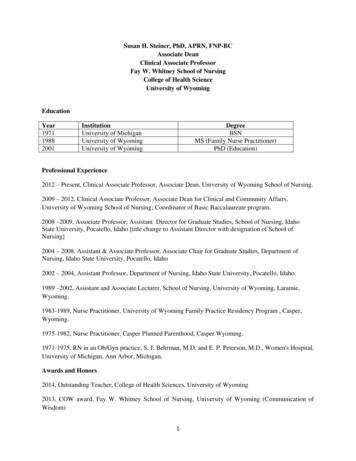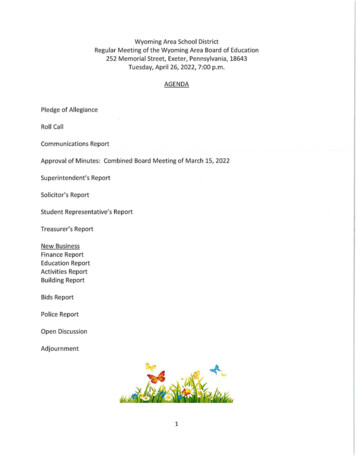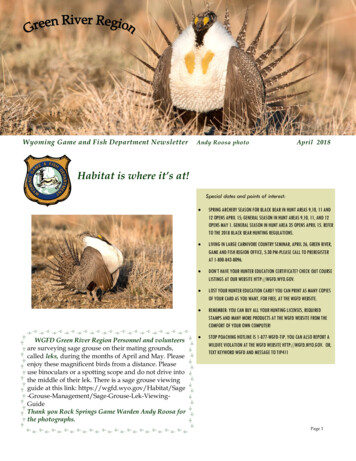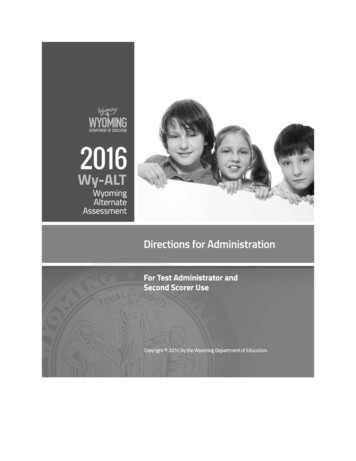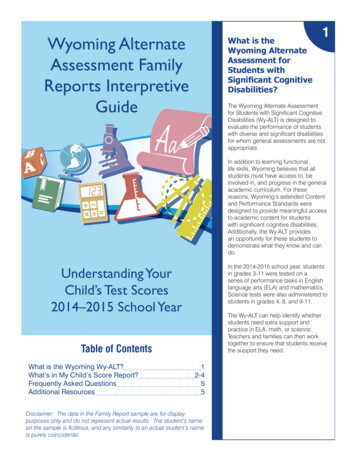
Transcription
Wyoming AlternateAssessment FamilyReports InterpretiveGuideWhat is theWyoming AlternateAssessment forStudents withSignificant CognitiveDisabilities?1The Wyoming Alternate Assessmentfor Students with Significant CognitiveDisabilities (Wy-ALT) is designed toevaluate the performance of studentswith diverse and significant disabilitiesfor whom general assessments are notappropriate.In addition to learning functionallife skills, Wyoming believes that allstudents must have access to, beinvolved in, and progress in the generalacademic curriculum. For thesereasons, Wyoming’s extended Contentand Performance Standards weredesigned to provide meaningful accessto academic content for studentswith significant cognitive disabilities.Additionally, the Wy-ALT providesan opportunity for these students todemonstrate what they know and cando.In the 2014-2015 school year, studentsin grades 3-11 were tested on aseries of performance tasks in Englishlanguage arts (ELA) and mathematics.Science tests were also administered tostudents in grades 4, 8, and 9-11.Understanding YourChild’s Test Scores2014–2015 School YearThe Wy-ALT can help identify whetherstudents need extra support andpractice in ELA, math, or science.Teachers and families can then worktogether to ensure that students receivethe support they need.Table of ContentsWhat is the Wyoming Wy-ALT? What’s in My Child’s Score Report? Frequently Asked Questions Additional Resources 12-455Disclaimer: The data in the Family Report sample are for displaypurposes only and do not represent actual results. The student’s nameon the sample is fictitious, and any similarity to an actual student’s nameis purely coincidental.
2Cover Letter The front page of your child’s score report includes an importantletter from the Wyoming Superintendent of Public Instruction summarizing thecontents of the report and encouraging you to be an active participant in yourchild’s education.FA M I LY S C O R E R E P O RTPrepared forWhat’s in My Child’s Score Report?The Family of Jane A. DoeTest Date:School:District:Grade 5Spring 2015Birth Date:01/02/2003AIR Elementary School (88)AIR District (1234567)Alternate Assessment for Students With Significant Cognitive DisabilitiesDear Parent or Guardian,The main purpose of the Wyoming Assessment System is to provide all students with achallenging and appropriate academic assessment. The Wyoming Alternate Assessmentfor Students with Significant Cognitive Disabilities (Wy-ALT) is designed to evaluate theperformance of students with disabilities for whom general assessments are not appropriate.The Wy-ALT represents a change in Wyoming’s alternate assessment, which previouslyrequired the administration of Student Performance Events (SPEs). The Wy-ALT is alignedto Wyoming’s new extended Content and Performance Standards and allows students todemonstrate their knowledge and skills in an appropriately challenging assessment. Janewas tested on a series of performance tasks in English language arts (ELA) and mathematics.These tasks are designed to be accessible and engaging to students with diverse andsignificant disabilities.The Family Score Report shows Jane’s overall scores on the test, the content and skills thatwere tested in each subject area, and information on what she knows, understands, and cando as well as recommendations for next steps. Jane’s teacher is the best person to explain theinformation contained in this report.Talk with Jane’s teacher and use these test results to help make sure that Jane receives achallenging and appropriate academic program. Doing so is an important step in ensuringher success.Sincerely,Jillian BalowSuperintendent of Public InstructionQuick Facts About Your Child and the Alternate AssessmentQ. Why does my child participate in standards-basedinstruction and assessment?Q. Where can I find more information about the alternateassessment and sample tasks?Wyoming believes that all students must have access to, beinvolved in, and progress in the general academic curriculum.Wyoming’s extended Content and Performance Standardswere created to provide meaningful access to academicFamilies can visit the Wyoming Alternate Assessment Portal(wyoassessment.org) to find more information, sampletasks, and FAQs related to the Wy-ALT. You are alsoencouraged to ask your child’s teacher how Wyoming’s
3Your Child’s Score Insidethe report, you will see your child’sperformance on the Wy-Alt. All studentsin grades 3–11 are assessed in ELAand mathematics. If your child is eligiblefor the science assessment, his or herperformance on that assessment is alsoreported.FA M I LY S C O R E R E P O RTAlternate AssessmenEnglish Language Arts Achievement ResultsAdvanced - Students are able to describe charactersin a story and summarize a story or informational text.They can read and write words and simple sentences.466Jane’sscore is 410.She has performedat the proficientlevel and meetsstandards for ELA.438MEETS STATE STANDARDAccelerated - Students can explain how actions ofcharacters affect the plot of a story.They recognize basicrules of punctuation.Proficient - Students follow events in a story and canrecall key details from an informational text (e.g., sciencebook).They understand ideas expressed in sentences.400371State Average Score: 402DOES NOT MEET STATE STANDARDWhat’s in My Child’s Score Report?575Basic - Students can identify main characters in storiesor the topic of an informational text (e.g., history book).They can connect simple words and phrases to pictures intext.Limited - Students have trouble demonstratingreading knowledge and skills.They need helpunderstanding spoken and written language.200How Was Your Child Assessed in ELA and What Does Her Result Indicate?WHAT THIS RESULT MEANSNEXT STEPSYour child scored in the proficient range. Students who score inIntroduce your child to different kinds of reading matethis range can answer factual questions about what they have readbooks, magazines, posters, greeting cards) and ask bas(e.g., Who invented the telephone? What did Mary eat for dessert?).about the text, such as, “What event is the poster aboutThey can identify more than one character in a story and explainreading with your child, ask her to point out words thahow characters interact with each other (e.g., two characters playedsimilar meanings (e.g, big/large, all/every). Point out lea board game together on a rainy day). They can identify wordswords (e.g., on street signs, in books) and ask your derstandtheeach letter. Ask your child’s teacher about other ways tComparisonScores Your child’smeaning of short sentences and simple phrases.continue your child’s learning at home.score on a subject assessment isPerformanceLevels If your child’s scorecompared with the average score for theis in the Advanced, Accelerated, or Proficientstateof Wyoming for that assessment.range in a Languagesubject, then your child has metLiteratureWyoming’scontent standards for that subject.Literature skills are based on understanding stories and poems.Language skills are based on understanding spoken and wIfyourchild’sscoreis in skillsthe Basicor definingLimited grade-appropriate vTested skills include identifying what a story is about, ddidnotmeetWyoming’san author’s point of view (i.e., who is telling the story), orderingwords, identifying when capital letters should be used, undproficiencystandardsfor that(e.g.,subjectevents in a story (i.e., first, next, last), and explaining similaritiesor figurativelanguage“fast inas thisthe wind,” “hungry as aadministrationoftheWy-ALT.differences between stories or poems.choosing words to use in conversation.Informational TextWritingInformational Text skills are based on understanding nonfictionwriting (e.g., biographies, newspaper articles, recipes). Tested skillsinclude identifying a topic, using text features to find informationWriting skills are based on using written English to expresTested skills include selecting a topic; writing simple wordsentences, and paragraphs; expressing opinions through w
4What This ResultMeans This sectionprovides parentsinformation on whatstudents generally knowand are Mathematicsable to do at Achievement Resultsyour child’s attainedperformance level.FA M I LY S C O R E R E P O RTAssessment for Students With Significant Cognitive Disabilities.WYOMING .GOVNext Steps The next steps466438400371State Average Score: 409200MEETS STATE STANDARDWhat’s in My Child’s Score Report?She has performedat the acceleratedlevel and meetsstandards formathematics.Advanced - Students can apply properties of arithmeticto solve problems including numeric fractions. They can usemultiplication to find area and generate numeric patterns.DOES NOT MEET STATE STANDARDJane’sscore is 445.575Accelerated - Students can apply properties of arithmeticto solve problems involving whole numbers and add and subtractdecimals. They can find perimeter when given side lengths.recommendations are basedon your child’s overall subjectlevel. This sectionProficient - Students can apply properties ofperformancearithmetic tosolve problems involving whole numbers.They canidentifyprovidesinformationonpolygons and understand concepts of area, perimeter andvolume.activities you can do with yourchildto build on strengths andBasic - Students can solve addition and subtractionproblemsbut struggle with multiplication and division problems.They can weaknesses in thealleviatecompare numbers and sort polygons.subjects assessed.Limited - Students have trouble demonstrating mathknowledge and skills.They struggle with tasks that involvenumerals but can work with those involving objects and models.How Was Your Child Assessed in Mathematics and What Does Her Result Indicate?WHAT THIS RESULT MEANSYour child scored in the accelerated range. Students who score inthis range can solve addition and subtraction problems involvingmulti-digit numbers including decimals (e.g., 1.50 - 0.25 1.25).They can add and subtract fractions with support of models (e.g.,given models, they can solve 1/2 1/4 3/4). They can find theperimeter when given the side lengths of a figure. They can solveaddition and subtraction measurement word problems (e.g., Theschool is 4 miles away. I’ve walked 2 miles. How much farther do Ineed to walk?).NEXT STEPSStrengthen your child’s understanding of fractions as part of awhole and practice writing the fractions. Use groups of objects todemonstrate the presence of fractions in everyday things, thenpractice writing the actual numerical fractions (e.g., cut an orangeinto four equal parts to show that each part is a quarter; point outthat one shoe represents half of a pair of shoes and that each shoerepresents the fraction, one-half). Ask your child’s teacher aboutother ways that you can continue your child’s learning at home.Counting and CardinalityMeasurement and DataCounting and Cardinality skills are based on understanding numbers.Tested skills include reading and writing numerals, understandingcounting sequences (e.g., “when given a number like 7, continueto count forward: 8, 9, 10.”), counting objects, and comparingnumerals and/or groups of objects.Measurement and Data skills are based on understandingmeasurement. Tested skills include describing and comparingmeasurable parts of objects, relating measurement to arithmetic,working with time and money, understanding geometricmeasurement (e.g., area), and representing or interpreting data.Operations and Algebraic ThinkingGeometryOperations and Algebraic Thinking skills are based on representingand solving problems. Tested skills include understanding andapplying properties of operations, solving and representing wordproblems and number sentences, and understanding arithmeticpatterns (e.g., even even even).Geometry skills are based on understanding shapes. Tested skillsinclude identifying and composing shapes, distinguishing definingattributes (e.g., types of triangles), using coordinate graphs, solvingproblems involving geometric measurement, and understandingcongruence and similarity.Number and Operations in Base TenNumber and Operations – FractionsNumber and Operations in Base Ten skills are based onunderstanding place value. Tested skills include using understandingof place value to perform arithmetic (e.g., 12 23 (10 20) (2 3) 30 5 35) and compare numbers (e.g., 20 50 because 2 5).Number and Operations - Fractions skills are based on understandingfractions. Tested skills include understanding fractions as numbers(e.g., one-fourth 1/4), applying properties of operations tofractions, comparing fractions, and translating between fractions anddecimals (e.g., 1/2 0.5).EDU.WYOMING .GOVSpring 2015 88-13WYOMING DEPARTMENT OF EDUCATIONContent Strands Assessed This sectiondescribes what areas were tested for each subjectadministered.
Glossary of Terms/DefinitionsContent Strand: A content subset within a subject5Performance Level: A proficiency level that corresponds to a score rangedetermined by a committee of Wyoming educatorsPerformance Level Descriptors: Detailed explanations of proficiencies and skillsthat correspond to each performance level for each grade/grade-band and subjectScore: A numerical value that is on a common scale so that children’s scores canbe compared over multiple test administrationsFrequently Asked Questions & Additional ResourcesStandards: Grade-band content that is assessed for accountability purposesFrequently Asked QuestionsWhy does my child participate in standardsbased instruction and assessment?In addition to learning functional life skills, Wyomingbelieves that all students must have access to, beinvolved in, and progress in the general academiccurriculum. For these reasons, Wyoming’s extendedContent and Performance Standards were designedto provide meaningful access to academic contentfor students with significant cognitive disabilities.Additionally, the Wy-ALT provides an opportunity forthese students to demonstrate what they know andcan do.How is the alternate assessment designed forstudents with significant cognitive disabilities?The Wy-ALT is designed to be accessible to studentswith diverse and significant disabilities. First, the testcontains performance tasks that range in complexity.Second, the test uses picture symbols and stimuli toengage students in the content. Third, the test allowsstudents to complete the tasks using their preferredmethod of communication (e.g., pointing, eye gaze,assistive technology, oral response, sign language).Fourth, two types of scripted test items are used:engagement, where the teacher rates the student’slevel of involvement; and scaffolded, where studentsare given multiple opportunities to respond correctly.Finally, there is no time restriction on the assessment;students may stop and resume the assessment at anypoint.What does my child’s performance level tell me?The performance levels indicate how often andaccurately your child demonstrates the knowledgeand skills being tested. Students are expected todemonstrate these skills at a proficient level or higher.Your child’s teacher will continue to work with yourchild to provide access to the general educationcurriculum and build upon his or her success.Additional ResourcesWhat are Wyoming’s extended Content andPerformance Standards and where can I learnmore about their effect on my child’s education?Wyoming’s extended Content and PerformanceStandards were created to provide meaningful accessto academic instruction for students with significantcognitive disabilities. The extended standards areorganized by grade-band. Specific standards areextended across three complexity levels, allowingteachers to adjust for various levels of difficulty. Theextended standards serve as the foundation for thedevelopment of the assessment tasks for the Wy-ALT.You can learn more about the extended standards byvisiting edu.wyoming.gov and searching “extendedstandards”.Where can I learn more about Wyoming’sAlternate Assessment?Families can visit the Wy-Alt Portal(wyoassessment.org) to find more information,including FAQs and sample tasks for the Wy-ALT.Families are also encouraged to speak with theirchild’s teacher to learn more.
challenging and appropriate academic assessment. The Wyoming Alternate Assessment for Students with Significant Cognitive Disabilities (Wy-ALT) is designed to evaluate the performance of students with disabilities for whom general assessments are not appropriate. The Wy-ALT represents a change in Wyoming's alternate assessment, which previously


